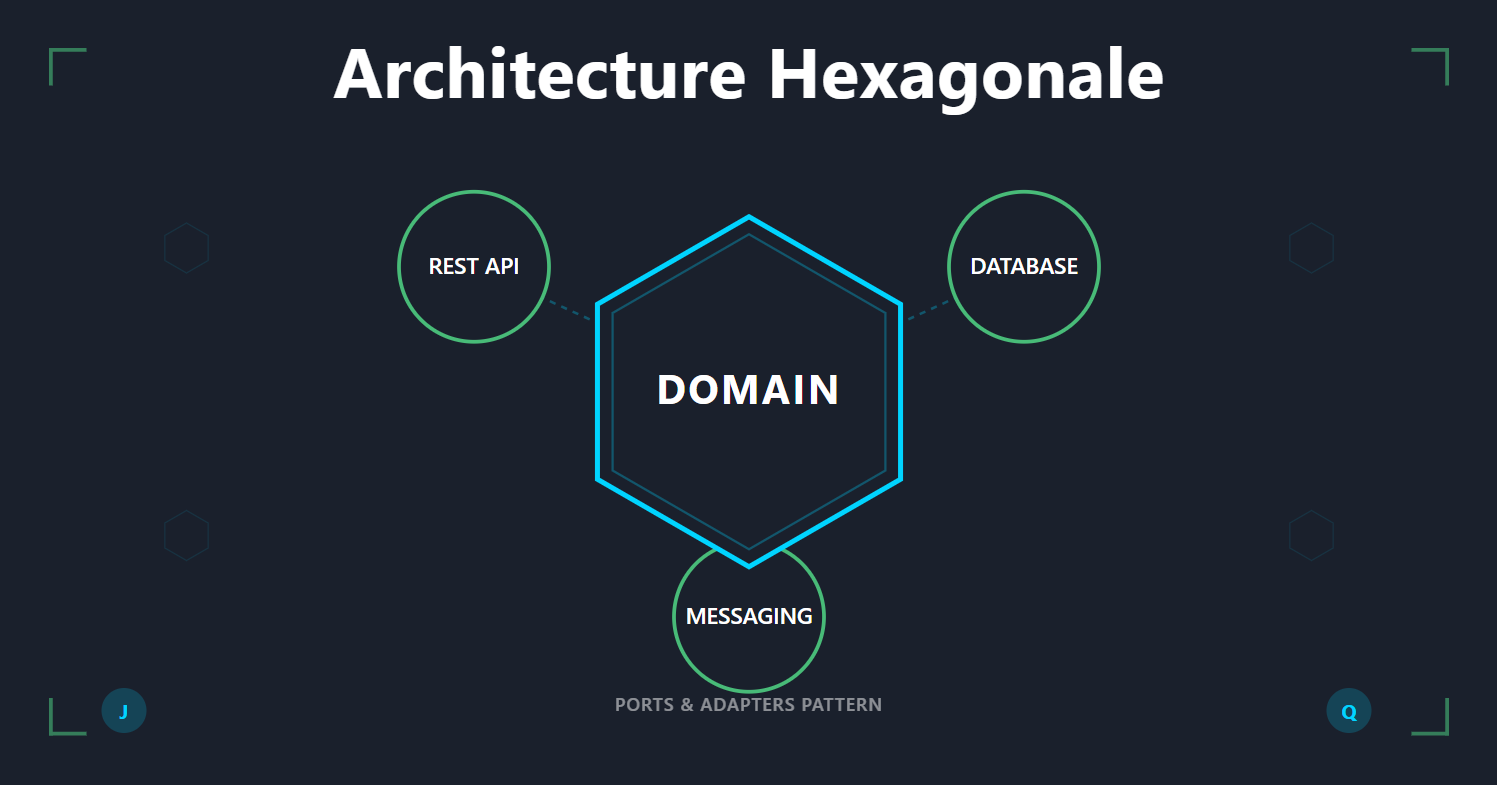🏗️ Hexagonal Architecture in Java: Structuring APIs for Maintainability
After exploring Quarkus performance, let’s talk about an equally crucial aspect: how to properly structure your API code. Hexagonal architecture (or “Ports & Adapters”) isn’t just a theoretical concept - it’s a pragmatic approach that transforms the maintainability of your Java projects.
🎯 The Problem with Traditional Architectures
How many times have you seen Spring Boot projects that end up like this:
- Fat Controllers: Business logic mixed with HTTP handling
- Anemic Services: Just CRUD operations that map to the database
- Tight Coupling: Impossible to test without starting the entire application
- Technical Debt: Each new feature becomes more complicated to implement
- Fragile Tests: Changing one dependency breaks all tests
The problem? Business logic is scattered everywhere, coupled to technical details (database, HTTP, etc.). Result: code that’s difficult to maintain and evolve.
🔄 Hexagonal Architecture: Clear Separation
The Fundamental Principle
The idea is simple: isolate business logic at the center, and decouple everything else (database, REST API, messaging, etc.) via interfaces.
| |
Concrete Benefits
✅ Isolated Tests: Test your business logic without starting the app
✅ Flexibility: Change database without impacting business logic
✅ Scalability: Easily add new entry channels (GraphQL, gRPC, etc.)
✅ Maintainability: Organized code, clear responsibilities
✅ Reusability: Business logic can be reused in different contexts
🏛️ Concrete Structure of a Hexagonal Project
Package Organization
| |
Layers Explained
Domain (the core):
- Entities: Business objects with their rules
- Ports: Interfaces defining contracts
- Use Cases: Pure business logic, no technical dependencies
Infrastructure (the periphery):
- Adapters In: REST Controllers, GraphQL endpoints, message consumers
- Adapters Out: JPA Repositories, HTTP clients, message publishers
- Config: Dependency injection, technical configuration
🛠️ Concrete Example with Quarkus
1. Business Entity (Domain)
| |
2. Port (Domain Interface)
| |
3. Use Case (Business Logic)
| |
4. REST Adapter (Infrastructure)
| |
5. Repository Adapter (Infrastructure)
| |
🧪 Testing: The Real Advantage
Use Case Unit Test
| |
Benefits:
- No application startup
- Fast tests (< 100ms)
- Isolated business logic
- Simple dependency mocking
Integration Test
| |
💡 Quarkus + Hexagonal Architecture: The Winning Combo
Why They Work Well Together?
Native Dependency Injection:
@ApplicationScopedfor use cases@Injectfor automatic port injection- Annotation-based configuration, no XML
Performance:
- Native compilation preserves architecture
- Fast startup even with complex structure
- Reflection eliminated, optimized interfaces
Integrated Testing:
@QuarkusTestfor integration tests@TestProfilefor different test environments- Native Mockito mocking
📊 Ideal Use Cases
Complex APIs with Rich Business Logic
- E-commerce applications (order management, pricing, inventory)
- Management systems (CRM, ERP, etc.)
- APIs with evolving business rules
Multi-Team Projects
- Clear separation of responsibilities
- Domain team vs infrastructure team
- Facilitated integration
Applications with Multiple Channels
- REST + GraphQL + gRPC
- Batch + API + Events
- Progressive migration from legacy systems
⚠️ When NOT to Use It?
Simple CRUD
For a basic API without complex business logic, it might be overkill. A simple Controller → Service → Repository pattern might suffice.
Rapid Prototypes
For a POC or demo, the complete structure might slow down initial development.
Junior Teams
There’s a learning curve. The team needs to be trained in DDD and hexagonal architecture concepts.
🚀 Getting Started
Steps to Begin
- Identify your business domain: What are your main entities?
- Define your use cases: What does your application actually do?
- Create the ports: What interfaces does your domain need?
- Implement the adapters: REST, database, etc.
- Test by layer: Domain → Use Cases → Adapters
Progressive Migration
No need to refactor everything at once:
- Start with new features
- Gradually isolate existing business logic
- Refactor the most critical parts
💡 Concrete Example
To see all these concepts in action, check out the demonstration repository that implements a complete Quarkus API with hexagonal architecture:
🔗 GitHub Repository - Quarkus Demo API
🔮 What’s Next?
Domain Driven Design (DDD)
Hexagonal architecture pairs perfectly with DDD:
- Aggregates, Value Objects, Domain Events
- Bounded contexts for large projects
- Event Sourcing for historization
CQRS (Command Query Responsibility Segregation)
Separate commands (write) from queries (read):
- Command use cases vs read use cases
- Separate performance optimization
- Improved scalability
🎉 In Summary
Hexagonal architecture + Quarkus means:
- Maintainable and scalable code
- Fast and reliable tests
- Technological flexibility
- Preserved performance
Yes, it requires a bit more initial effort. But in the long run, you gain enormously in productivity and peace of mind.
Hexagonal architecture isn’t just an academic pattern - it’s a pragmatic tool for robust and durable APIs.
Are you already testing it? Share your feedback!
